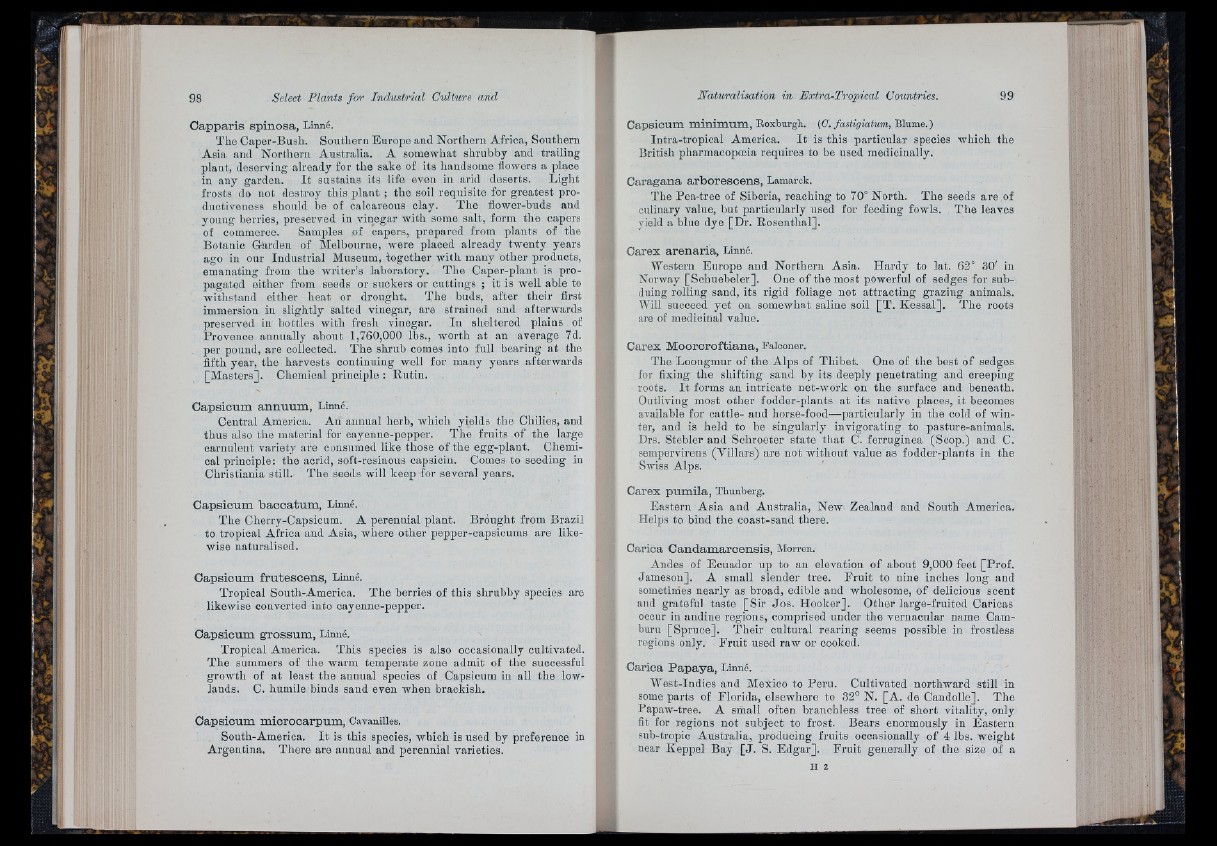
C a p p a r i s s p in o s a , Linné.
The Caper-Bush. Southern Europe and Northern Africa, Southern
Asia and Northern Australia. A somewhat slirubby and trailing
plant, deserving already for the sake of its handsome flowers a place
in any garden. I t sustains its life even in arid deserts. Light
frosts do not destroy this plant ; the soil requisite for greatest productiveness
should be of calcareous clay. The flower-buds and
young berries, preserved in vinegar with some salt, form the capers
of commerce. Samples of capers, prepared from plants of the
Botanic Garden of Melbourne, were placed already twenty years
ago in our Industrial Museum, together with many other products,
emanating from the writer’s laboratory. The Caper-plant is propagated
either from seeds or suckers or cuttings ; it is well able to
withstand eitlier heat or drought. The bnds, after their first
immersion in slightly salted vinegar, are strained and afterwards
preserved in bottles with fresh vinegar. In sheltered plains of
Provence annually about 1,760,000 lbs., worth at an average 7d.
per pound, are collected. The shrub comes into full bearing a t the
fifth year, the harvests continuing well for many years afterwards
[Masters]. Chemical principle : Rutin.
C a p s ic um a n n u u m , Linné.
Central America. An annual herb, whicli yields the Chilies, and
thus also the material for cayenne-pepper. The fruits of the large
carnulent variety are consumed like those of the egg-plant. Chemical
principle: the acrid, soft-resinous capsicin. Comes to seeding in
Christiania still. The seeds will keep for several years.
C a p s ic um b a c c a tu m , Linné.
The Cherry-Capsioum. A perennial plant. Brought from Brazil
to tropical Africa and Asia, where other pepper-oapsicums are likewise
naturalised.
C a p s ic um f r u t e s c e n s , Linné.
Tropical South-America. The berries of this shrubby species are
likewise converted into cayenne-pepper.
C a p s ic um g r o s s u m , Linné.
Tropical America. This species is also occasionally cultivated.
The summers of the warm temperate zone admit of the successful
growth of a t least the annual species of Capsicum in all the lowlands.
C. humile binds sand even when brackish.
C a p s ic um m ic r o c a r p u m , Cavanilles.
South-America. I t is this species, which is used by preference in
Argentina. There are annual and perennial varieties.
C a p s ic um m in im u m , Roxburgh. (C./aste'gi'afttm, Blume.)
Intra-tropical America. I t is this particular species which the
British pharmacopoeia requires to be used medicinally.
C a r a g a n a a r b o r e s c e n s , Lamarck.
The Pea-tree of Siberia, reaching to 70° North. The seeds are of
culinary value, but particularly used for feeding fowls. The leaves
yield a blue dye [Dr. Rosenthal].
C a re x a r e n a r ia , Linné.
Western Europe and Northern Asia. Hardy to lat. 62° 30' in
Norway [Schnebeler]. One of the most powerful of sedges for subduing
rolling sand, its rigid foliage not attracting grazing animals.
AVill succeed yet on somewhat saline soil [T . Kessal]. 'The roots
are of medicinal value.
C a re x M o o r c r o f ti a n a , Falconer.
The Loongmur of the Alps of Thibet. One of the best of sedges
for fixing the shifting sand by its deeply penetrating and creeping
roots. I t forms an intricate net-work on the surface and beneath.
Outliving most other fodder-plants at its native places, it becomes
available for cattle- and horse-food—particularly in the cold of winter,
and is held to he singularly invigorating to pasture-animals.
Drs. Stebler and Schroeter state that C. ferruginea (Scop.) and C.
sempervirens (Villars) are not without value as fodder-plants in the
Swiss Alps.
C a rex p u m il a , Thunberg.
Eastern Asia and Australia, New Zealand and South America.
Helps to bind the coast-sand there.
C a ric a C a n d am a r c e n s i s , Morren.
Andes of Ecuador up to an elevation of about 9,000 feet [Prof.
Jameson]. A small slender tree. F ru it to nine inches long and
sometimes nearly as broad, edible and wholesome, o f delicious scent
and grateful taste [S ir Jos. Hooker]. Other large-fruited Carioas
occur in andine regions, comprised under the vernacular name Cam-
bum [Spruce]. 'Their cultural rearing seems possible in frostless
regions only. F ru it used raw or cooked.
C a ric a P a p a y a , Linné.
West-Indies and Mexico to Peru. Cultivated northward still in
some parts of Plorida, elsewhere to 32° N. [A. de Candolle]. The
Papaw-tree. A small often branchless tree of short vitality, only
fit for regions not subject to frost. Bears enormously in Eastern
sub-tropic Australia, producing fruits occasionally of 4 lbs. weight
near Keppel Bay [J . S. Edgar]. Fruit generally of the size of a
f r